Jewish Folktales and Talmudic Stories (Page 5) |
If you wish to purchase any of these books, click on either the title or the book cover to be directed to Amazon.com. As a warning, I have put up pictures of the book covers to give you somewhat an idea of the style of each book (I know, I know. "Don't judge a book by its cover") so the pages may load slowly, depending on the speed of your internet connection.
If this page came up without frames, Click here to see the complete website
Other Pages of Interest:
Jewish Folktales and Talmudic Stories for Children
(Page 1)
(Page 2)
(Page 3)
(Page 4)
(Page 5)
(Page 6)
(Page 7)
Easy Reader and Picture Books:
Jewish Children's Books (General) |
Jewish Board Books |
Biblical Stories for Children |
Jewish Holiday Books |
Jewish Family Cookbooks |
Jewish Folktales and Talmudic Stories for Children
(Page 1)
(Page 2)
(Page 3)
(Page 4)
(Page 5)
(Page 6)
(Page 7)
|
Jewish Life Books (Mitzvot, Keeping Kosher, etc.) |
Jewish Life Cycle Books |
Family Haggadahs |
Children's Prayerbooks |
Introductory Hebrew Books |
Jewish History and Historical Fiction Picture Books |
Israel Books
Middle School and YA Books:
Bar Mitzvah Books |
Jewish Fiction |
Historical Fiction |
Torah Study |
Prayer and Jewish Life Books |
Jewish Holidays |
Jewish Biographies |
Jewish History Books |
Holocaust Books for Teens |
Israel Books
Jewish Books for Children |
Bar Mitzvah Books |
Jewish Parenting Books |
Jewish Music for Children |
Jewish Videos |
Jewish Toys and Gifts |
Jewish Gift Baskets and Gourmet Food |
Jewish Jewelry |
Amazon.com Coupons, Promotions, and Sales

Jewish Fairy Tales
By Gerald Friedlander
Travel back to a land at the intersection of folklore and religion. The 23 authentic Jewish fairy tales in this book, brought together from the Talmud and other ancient sources, including the Jewish Chap Book, the Midrash Rabbah, Beth Hammidrash, Tanhuma, and Rabbi Eliezer, will surround you with angels, demons, goblins and an amazing assortment of Old Testament prophets and sages. In several of these stories, the prophet Elijah -- "always at hand to comfort the sorrowful, cheer the despondent, and help those in distress" -- assumes a role similar to that of a fairy godmother, creating miracles that change people's lives.
In "The Magic Apples," Elijah provides some anti-leprosy medication that helps a young man gain a fortune and win the hand of his beautiful cousin. In "The Goblin and the Princess," an obliging little ogre helps two wise men convince the Roman emperor to let the Jews continue to observe the Sabbath and their holy laws. Fate intervenes in "The Princess and the Beggar" when a lovely young princess is forced by her father to live in isolation. The greedy king of "The Demon's Marriage" is tricked into wedding his daughter to the Son of Satan. And in "The Magic Leaf," a holy man is punished for meddling with mysteries of life and death. These and 18 other entertaining and instructive stories from Jewish legend and lore are sure to enthrall a new generation of fairy tale enthusiasts.
Description from Publisher
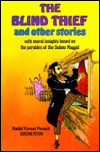
Blind Thief and Other Stories

Run for Your Life and Other Stories
By Rabbi Yisroel Pesach Sochertov
The moral insights and parables of the Maggid of Dubno, presented
as contemporary stories for young readers.
Description from Publisher
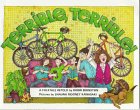
Terrible, Terrible! :
A Retold Folktale
By Robin Bernstein
In this contemporary version of the old Yiddish tale "It Could Always
Be Worse," a female rabbi advises Abigail, a young girl new to a blended
family, how to relieve the overcrowding at home. After bringing in seven
bicycles, seven pets, and dozens of cousins, then getting rid of them all
and cleaning the house, everyone agrees "their lives were wonderful,
wonderful, better than ever." The brightly colored illustrations are
appropriately crowded if a little stiff.
Description from Horn Book

Lights Along the Path Jewish Folklore Through The Grades
By Rebecca Schacht
Lights Along The Path is a graded collection of Jewish
folkloric tales, from the familiar to the obscure, from ancient
Midrashic and Talmudic sources, for children ages four to
twelve. Ideal to read aloud, and entertaining and educational
for older readers, the stories are enhanced with beautiful
illustrations, sidbar "tidbits," and annotations. The book
sections include: Kindergarten, Grades One to Three, Grades
Four to Six, Idex, and Glossary.
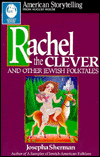
Rachel the Clever and Other Jewish Folktales
By Josepha Sherman
A lively and well-rounded collection of folktales, ranging from
humorous to hilarious to ghostly highjinks. It is refreshing that
Sherman has chosen to present such a diversity of folklore,
rather than relying strictly on tales from Eastern Europe. In
this slim volume, 46 stories from Spain, Iran, Central Asia,
Poland, and Tunisia, among others, portray the variety of Jewish
experiences in the Diaspora. Readers and listeners will be intrigued
by the similarity of cross-cultural folkloric traditions, and will
delight in the familiar old stories of the Wise Men of Chelm. The
author's notes add the right historical flavor. A fine choice for
storytellers, it is also a wonderful pick for reading aloud.
from School Library Journal
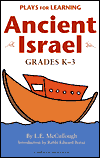
Plays of Ancient Israel:
Legends from the Bible and Jewish Folklore
By L. E. McCullough
The land of Israel has long been a fertile spawning ground for some of the greatest stories ever told - which are now dramatized for your stage! Plays of Ancient Israel presents 12 exciting one-acts from the Old Testament and the treasure trove of Jewish folklore and ritual: Noah, Moses, Jonah, Samson & Delilah, David & Goliath, Ruth and Naomi, King Solomon, tales from the Talmud, origins of Hanukkah, Purim and more.
Description from Publisher
Though the title suggests that these dramatic interpretations of Bible stories and legends from the Midrash target children in grades K to three, the sophistication of the dialogue and plots make them more suitable for older students. The works range from a retelling of the story of Jonah to a less widely known adventure of Elijah the prophet. The text assumes its audience will be familiar with biblical narrative; for example, a character at the end of the tale of Ruth and Naomi comments that Ruth will give birth to a child renowned throughout Israel without making it clear that she is an ancestor of King David. The adults in charge of the productions will appreciate the clear stage directions and flexible casting requirements. For example, a story about angels on earth calls for a 21-member cast, but the play may be performed with 6 boys and 3 girls. Children will appreciate the modern humor injected into standard Sunday-school fare. When Jonah realizes that he has brought God's anger upon the ship he comments, "I was afraid this might happen, but that's the way the prophet bounces." A note outlines each story's origin. A diagram of the stage set; music scores; and descriptions of the set, cast, music, props, and costumes accompany each selection. A good choice for adults looking for a way to enliven religious-school curriculum
Description from School Library Journal
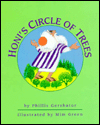
Honi's Circle of Trees
By Phillis Gershator
Honi, a character from Talmudic legend, is known for three things: the planting
of carob trees across ancient Israel, his ability to communicate with God from
within an iconographic circle, and for his selflessness-he plants not for himself,
but for the generations to come. In its previous incarnation,
Honi and His
Magic Circle, three separate episodes in the wanderer's life were related.
This version has a cohesive story line and animated folk-style illustrations.
Honi wanders the land planting his seeds, comes to a village where a man
remembers his rain miracle from years before and leads the old man to take a
rest. When Honi awakens from what he thought was his nap, he learns that 70 years
have passed; confused and upset at first, he realizes that he has been allowed
to see his trees bear fruit. This is a lovely book not only for the Jewish
holiday of Sukkot or Tu B'Shevat, but for any library that wants a book on
ecology or selflessness. An appealing retelling.
Description from School Library Journal
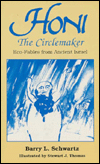
Honi the Circlemaker:
Eco-Fables from Ancient Israel
By Barry L. Schwartz
This charming book tells the story of a man who travels throughout the
land of Israel planting carob seeds wherever he goes. Ancient Israel is
no Garden of Eden, as the people of Honi's town discover when they are
plagued alternately by drought and flood. But Honi teaches them how to
live in right relationship with the creation and the Creator. Complemented
by beautiful illustrations, these tales will encourage children and
adults alike to appreciate the connection between their faith and their
desire for a healthy, bountiful earth.
Description from Publisher
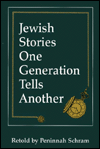
Jewish Stories One Generation Tells Another
By Peninnah Schram
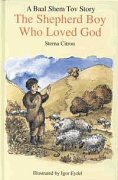
The Shepherd Boy Who Loved God:
A Baal Shem Tov Story
By Sterna Citron

Na'ar Hayisi:
I Was a Child
By Aidel Wajngort
This collection of 42 short stories is a treasure-trove of anecdotes
about our Sages when they were young. These unique tales show that
our Sages were already distinguished even before they became great
leaders.
Includes stories about the Maggid of Mehzrich, the Vilna Gaon, Rav
Simcha Bunem of Peshischa, Rav Elchanan Wasserman, and many others.
Description from Publisher
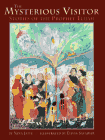
The Mysterious Visitor :
Stories of the Prophet Elijah
By Nina Jaffe
The mysterious visitor of the title is the biblical Elijah, who began his career
as a stern prophet and metamorphosed into a benevolent protector and wishgiver
in folklore. Jaffe has chosen and adapted eight stories out of the hundreds from
all over the Jewish world that contain references to Elijah. Though centered on
a biblical prophet, the stories will not be unfamiliar in either structure or
substance to young readers. In one tale from France, Elijah comes and offers a
choice of wishes to three brothers: riches, wisdom, or a wise and righteous
wife. In another piece, set in Morocco, an evil spirit gives the woman the face
of a donkey. Each of these engagingly told stories has at its core such values
as love of learning, respect for marriage, and the Golden Rule. Illustrator
Elivia Savadier provides one full-page pen-and-watercolor illustration,
Chagall-like in feeling, for every tale. Adults will be interested in the
author's note that gives the derivation of the stories. An informative glossary
and a bibliography are also appended.
from Booklist
Page 1 |
Page 2 |
Page 3 |
Page 4 |
Page 5 |
Page 6 |
Page 7
Still can't find what you're looking for? Search Amazon.com's database directly.
©1999-2009
(NOTE: The following links have NOT been placed on the site by the website owners. We have no control over which ads are selected and are not responsible for their religious content.)
If this page came up without frames, Click here to see the complete website
Other Pages of Interest:
Jewish Folktales and Talmudic Stories for Children
(Page 1)
(Page 2)
(Page 3)
(Page 4)
(Page 5)
(Page 6)
(Page 7)
Easy Reader and Picture Books:
Jewish Children's Books (General) |
Jewish Board Books |
Biblical Stories for Children |
Jewish Holiday Books |
Jewish Family Cookbooks |
Jewish Folktales and Talmudic Stories for Children
(Page 1)
(Page 2)
(Page 3)
(Page 4)
(Page 5)
(Page 6)
(Page 7)
|
Jewish Life Books (Mitzvot, Keeping Kosher, etc.) |
Jewish Life Cycle Books |
Family Haggadahs |
Children's Prayerbooks |
Introductory Hebrew Books |
Jewish History and Historical Fiction Picture Books |
Israel Books
Middle School and YA Books:
Bar Mitzvah Books |
Jewish Fiction |
Historical Fiction |
Torah Study |
Prayer and Jewish Life Books |
Jewish Holidays |
Jewish Biographies |
Jewish History Books |
Holocaust Books for Teens |
Israel Books
Jewish Books for Children |
Bar Mitzvah Books |
Jewish Parenting Books |
Jewish Music for Children |
Jewish Videos |
Jewish Toys and Gifts |
Jewish Gift Baskets and Gourmet Food |
Jewish Jewelry |
Amazon.com Coupons, Promotions, and Sales
Other Pages of Interest:
Jewish Folktales and Talmudic Stories for Children
(Page 1)
(Page 2)
(Page 3)
(Page 4)
(Page 5)
(Page 6)
(Page 7)
Easy Reader and Picture Books:
Jewish Children's Books (General) |
Jewish Board Books |
Biblical Stories for Children |
Jewish Holiday Books |
Jewish Family Cookbooks |
Jewish Folktales and Talmudic Stories for Children
(Page 1)
(Page 2)
(Page 3)
(Page 4)
(Page 5)
(Page 6)
(Page 7)
|
Jewish Life Books (Mitzvot, Keeping Kosher, etc.) |
Jewish Life Cycle Books |
Family Haggadahs |
Children's Prayerbooks |
Introductory Hebrew Books |
Jewish History and Historical Fiction Picture Books |
Israel Books
Middle School and YA Books:
Bar Mitzvah Books |
Jewish Fiction |
Historical Fiction |
Torah Study |
Prayer and Jewish Life Books |
Jewish Holidays |
Jewish Biographies |
Jewish History Books |
Holocaust Books for Teens |
Israel Books
Jewish Books for Children |
Bar Mitzvah Books |
Jewish Parenting Books |
Jewish Music for Children |
Jewish Videos |
Jewish Toys and Gifts |
Jewish Gift Baskets and Gourmet Food |
Jewish Jewelry |
Amazon.com Coupons, Promotions, and Sales
Easy Reader and Picture Books:
Jewish Children's Books (General) | Jewish Board Books | Biblical Stories for Children | Jewish Holiday Books | Jewish Family Cookbooks | Jewish Folktales and Talmudic Stories for Children (Page 1) (Page 2) (Page 3) (Page 4) (Page 5) (Page 6) (Page 7) | Jewish Life Books (Mitzvot, Keeping Kosher, etc.) | Jewish Life Cycle Books | Family Haggadahs | Children's Prayerbooks | Introductory Hebrew Books | Jewish History and Historical Fiction Picture Books | Israel Books
Middle School and YA Books:
Bar Mitzvah Books | Jewish Fiction | Historical Fiction | Torah Study | Prayer and Jewish Life Books | Jewish Holidays | Jewish Biographies | Jewish History Books | Holocaust Books for Teens | Israel Books
Jewish Books for Children | Bar Mitzvah Books | Jewish Parenting Books | Jewish Music for Children | Jewish Videos | Jewish Toys and Gifts | Jewish Gift Baskets and Gourmet Food | Jewish Jewelry | Amazon.com Coupons, Promotions, and Sales
 Jewish Fairy Tales By Gerald Friedlander |
Travel back to a land at the intersection of folklore and religion. The 23 authentic Jewish fairy tales in this book, brought together from the Talmud and other ancient sources, including the Jewish Chap Book, the Midrash Rabbah, Beth Hammidrash, Tanhuma, and Rabbi Eliezer, will surround you with angels, demons, goblins and an amazing assortment of Old Testament prophets and sages. In several of these stories, the prophet Elijah -- "always at hand to comfort the sorrowful, cheer the despondent, and help those in distress" -- assumes a role similar to that of a fairy godmother, creating miracles that change people's lives.
In "The Magic Apples," Elijah provides some anti-leprosy medication that helps a young man gain a fortune and win the hand of his beautiful cousin. In "The Goblin and the Princess," an obliging little ogre helps two wise men convince the Roman emperor to let the Jews continue to observe the Sabbath and their holy laws. Fate intervenes in "The Princess and the Beggar" when a lovely young princess is forced by her father to live in isolation. The greedy king of "The Demon's Marriage" is tricked into wedding his daughter to the Son of Satan. And in "The Magic Leaf," a holy man is punished for meddling with mysteries of life and death. These and 18 other entertaining and instructive stories from Jewish legend and lore are sure to enthrall a new generation of fairy tale enthusiasts. |
 Blind Thief and Other Stories  Run for Your Life and Other Stories By Rabbi Yisroel Pesach Sochertov |
The moral insights and parables of the Maggid of Dubno, presented
as contemporary stories for young readers.
|
 Terrible, Terrible! : A Retold Folktale By Robin Bernstein |
In this contemporary version of the old Yiddish tale "It Could Always
Be Worse," a female rabbi advises Abigail, a young girl new to a blended
family, how to relieve the overcrowding at home. After bringing in seven
bicycles, seven pets, and dozens of cousins, then getting rid of them all
and cleaning the house, everyone agrees "their lives were wonderful,
wonderful, better than ever." The brightly colored illustrations are
appropriately crowded if a little stiff.
|
 Lights Along the Path Jewish Folklore Through The Grades By Rebecca Schacht |
Lights Along The Path is a graded collection of Jewish folkloric tales, from the familiar to the obscure, from ancient Midrashic and Talmudic sources, for children ages four to twelve. Ideal to read aloud, and entertaining and educational for older readers, the stories are enhanced with beautiful illustrations, sidbar "tidbits," and annotations. The book sections include: Kindergarten, Grades One to Three, Grades Four to Six, Idex, and Glossary. |
 Rachel the Clever and Other Jewish Folktales By Josepha Sherman |
A lively and well-rounded collection of folktales, ranging from
humorous to hilarious to ghostly highjinks. It is refreshing that
Sherman has chosen to present such a diversity of folklore,
rather than relying strictly on tales from Eastern Europe. In
this slim volume, 46 stories from Spain, Iran, Central Asia,
Poland, and Tunisia, among others, portray the variety of Jewish
experiences in the Diaspora. Readers and listeners will be intrigued
by the similarity of cross-cultural folkloric traditions, and will
delight in the familiar old stories of the Wise Men of Chelm. The
author's notes add the right historical flavor. A fine choice for
storytellers, it is also a wonderful pick for reading aloud.
|
 Plays of Ancient Israel: Legends from the Bible and Jewish Folklore By L. E. McCullough |
The land of Israel has long been a fertile spawning ground for some of the greatest stories ever told - which are now dramatized for your stage! Plays of Ancient Israel presents 12 exciting one-acts from the Old Testament and the treasure trove of Jewish folklore and ritual: Noah, Moses, Jonah, Samson & Delilah, David & Goliath, Ruth and Naomi, King Solomon, tales from the Talmud, origins of Hanukkah, Purim and more.
Though the title suggests that these dramatic interpretations of Bible stories and legends from the Midrash target children in grades K to three, the sophistication of the dialogue and plots make them more suitable for older students. The works range from a retelling of the story of Jonah to a less widely known adventure of Elijah the prophet. The text assumes its audience will be familiar with biblical narrative; for example, a character at the end of the tale of Ruth and Naomi comments that Ruth will give birth to a child renowned throughout Israel without making it clear that she is an ancestor of King David. The adults in charge of the productions will appreciate the clear stage directions and flexible casting requirements. For example, a story about angels on earth calls for a 21-member cast, but the play may be performed with 6 boys and 3 girls. Children will appreciate the modern humor injected into standard Sunday-school fare. When Jonah realizes that he has brought God's anger upon the ship he comments, "I was afraid this might happen, but that's the way the prophet bounces." A note outlines each story's origin. A diagram of the stage set; music scores; and descriptions of the set, cast, music, props, and costumes accompany each selection. A good choice for adults looking for a way to enliven religious-school curriculum |
 Honi's Circle of Trees By Phillis Gershator |
Honi, a character from Talmudic legend, is known for three things: the planting
of carob trees across ancient Israel, his ability to communicate with God from
within an iconographic circle, and for his selflessness-he plants not for himself,
but for the generations to come. In its previous incarnation,
Honi and His
Magic Circle, three separate episodes in the wanderer's life were related.
This version has a cohesive story line and animated folk-style illustrations.
Honi wanders the land planting his seeds, comes to a village where a man
remembers his rain miracle from years before and leads the old man to take a
rest. When Honi awakens from what he thought was his nap, he learns that 70 years
have passed; confused and upset at first, he realizes that he has been allowed
to see his trees bear fruit. This is a lovely book not only for the Jewish
holiday of Sukkot or Tu B'Shevat, but for any library that wants a book on
ecology or selflessness. An appealing retelling.
|

Honi the Circlemaker: Eco-Fables from Ancient Israel By Barry L. Schwartz |
This charming book tells the story of a man who travels throughout the
land of Israel planting carob seeds wherever he goes. Ancient Israel is
no Garden of Eden, as the people of Honi's town discover when they are
plagued alternately by drought and flood. But Honi teaches them how to
live in right relationship with the creation and the Creator. Complemented
by beautiful illustrations, these tales will encourage children and
adults alike to appreciate the connection between their faith and their
desire for a healthy, bountiful earth.
|

Jewish Stories One Generation Tells Another By Peninnah Schram |
|
 The Shepherd Boy Who Loved God: A Baal Shem Tov Story By Sterna Citron |
|
 Na'ar Hayisi: I Was a Child By Aidel Wajngort |
This collection of 42 short stories is a treasure-trove of anecdotes
about our Sages when they were young. These unique tales show that
our Sages were already distinguished even before they became great
leaders.
Includes stories about the Maggid of Mehzrich, the Vilna Gaon, Rav Simcha Bunem of Peshischa, Rav Elchanan Wasserman, and many others. |
 The Mysterious Visitor : Stories of the Prophet Elijah By Nina Jaffe |
The mysterious visitor of the title is the biblical Elijah, who began his career
as a stern prophet and metamorphosed into a benevolent protector and wishgiver
in folklore. Jaffe has chosen and adapted eight stories out of the hundreds from
all over the Jewish world that contain references to Elijah. Though centered on
a biblical prophet, the stories will not be unfamiliar in either structure or
substance to young readers. In one tale from France, Elijah comes and offers a
choice of wishes to three brothers: riches, wisdom, or a wise and righteous
wife. In another piece, set in Morocco, an evil spirit gives the woman the face
of a donkey. Each of these engagingly told stories has at its core such values
as love of learning, respect for marriage, and the Golden Rule. Illustrator
Elivia Savadier provides one full-page pen-and-watercolor illustration,
Chagall-like in feeling, for every tale. Adults will be interested in the
author's note that gives the derivation of the stories. An informative glossary
and a bibliography are also appended.
|